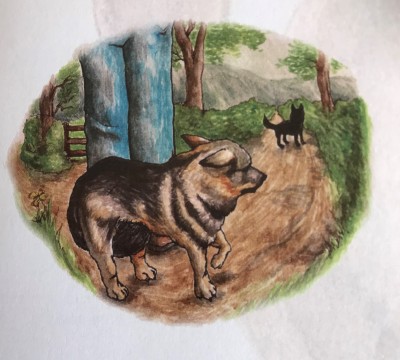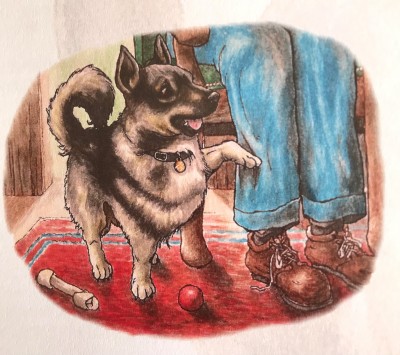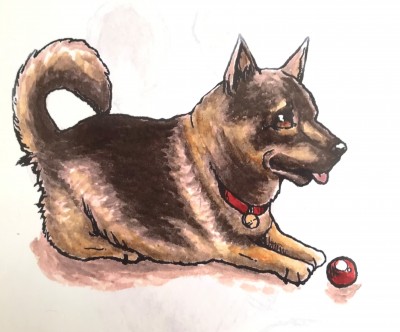Training Your Human
This month our theme is How To Train Your Human. This is taken from a book written by well-known author Sammy Vallhund to help all dogs with training their humans. Sammy is now 13 years old and this was written when he was a youngster but well-practised in all aspects of training humans and the principles still apply today.
Statutory warning.
To comply with the law regarding books on training humans this section is to remind all dogs and especially Vallhunds that it is essential to ensure that humans continue to believe that they are in charge of Vallhunds. Our forebears have spent thousands of years conditioning humans to believe this and it is of the utmost importance that we, and our descendants, continue this deception. So without further delay – How to Train Your Human…
- Why bother?
A well trained human can not only provide us with the basics we need such as food and bedding but can ensure we have a full social life, remain active and healthy into old age and have our every need responded to promptly. Although this book can be used by any dog it is aimed in particular at Swedish Vallhunds as Vallhunds have especially well-developed characters for training humans
- Techniques
Before looking at what we want our humans to do let’s look at the techniques that we have at our disposal.
-
- Vocal
Vallhunds have a wide vocal repertoire at their disposal so the key part of training is to be sure to use the same sound associated with the specific behaviour that is expected. A reminder here that although deafness in young and middle age Vallhunds is rare, a large percentage of humans seem to be deaf throughout their life. It is for this reason that you may have to repeat a command many times before your human hears it. In some cases it may be necessary to reinforce one command technique, for example a woof, with a reminder/reinforcement command such as a barge in the back of the leg. The ideal, of course, is to ensure your human responds immediately to the first command or attention attracting woof. This is very rarely the case - very few will respond instantly and repeat woofing may well be required.
-
- Physical
Ears: Some examples perhaps best illustrate ear use:
- Up and alert – useful to reinforce another command such as time for a walk
- Flat and down – your human has returned but left you alone for longer than he was supposed to
- Up and rotating – remind your human that he is entirely dependent on you for his personal safety and that he had better have purchased a large supply of your favourite chew
Tail: Vallhunds with no tail please ignore this section
- Tail fully tucked under the belly – I’m not in the least afraid of the giant black slavering dog in front of me but it is essential that you stand in front of me so my stare doesn’t frighten him too much
- Tail fully erect – follow me, this is where I wish to walk
- Tail wagging - this command is context sensitive and so can be used in a variety of situations:
- Your human has returned - wagging in this context could indicate your approval that he has correctly understood the command to purchase more chews
- Your human has gone to the door with his lead after you have indicated that it’s time for your walk. The wag is in this case is confirmation that he has correctly understood the requirement and continues to reassure him that his action is correct. You need to remember that humans have extremely short attention spans and can be very slow to respond to commands, so the wagging indicates that he should continue with his current action.
Head: Tilting the head from side to side shows the human that you are awaiting confirmation that your previous command has been registered in his brain
Paw: Most typically used as a gentle prod on the front of a human’s leg as a reminder that a previous command has not yet been obeyed. Can be used more vigorously in circumstances where your human has taken so long to respond to a command that you are concerned that he has died on the sofa.
Barging: Here varying force appropriate to the situation is needed from a gentle nudge just behind the knee to a full-on charge behind the knee. Barging is normally used as a reminder/reinforcer to a previously issued command when the human has not registered a command or is too slow in doing it. Remember we’re striving for a situation where the human responds at once to our requirement in our time, not in their own good time.
Double stare: This technique can be used on its own or to reinforce another command such as ‘Get me my tea now’. Sit and stare fixedly at, for example, the food container for perhaps 10 seconds, then with a vigorous switch of direction stare at your human
- Socialising
It’s essential to determine what your requirements are for socialising, whether you want your human to have extra obedience training or, if you feel they need conditioning then possibly agility sessions would help, or it might simply be that you wish to check your territory and meet your friends morning and evening. Indeed, you may decide that all the above are required so we’ll use the example of a walk to indicate the sort of training techniques that are appropriate.
Firstly, timing - when do you wish to go out socialising? At your chosen time gain the attention of your human with a single woof (see note above in 2.1 about multiple woofing) then take them to the front door. (Note: depending on your requirements you may need to ensure that they have been to the refrigerator to collect your liver cake, sausage and Edam cheese treats). It’s best to start simple, so take them to the front door. This may again require multiple woofing near the front door.
Humans have so little intelligence that they may fail to understand even this most simple command. It may be necessary to repeat this command but in the early stages try to keep the commands simple until you’re sure the human knows what is required. Much later when the human knows what behaviour is expected but is simply too slow in carrying it out then use of the reinforcing behaviours such as barging and multiple woofing is to be encouraged.
Secondly, on or off the lead?? There is no right answer as to whether you want your human on or off the lead. It all depends on the circumstances and, let’s be frank, some Vallhunds simply want the opportunity to show off their pet human and hence have them on the lead. As a general rule if you feel that your human could be in any form of danger or if you feel that you need an immediate response to a command then put them on lead.
- Useful behaviours to teach your human
Door opening: You can of course simply use the standard woof at the door to instruct your human. However, with a little patience a much more satisfactory result can be achieved - a “tie” attached to the door which allows you to open the door without having to wait for your sometimes forgetful and idle human to open the door.
Steps to getting there:
- Find any piece of rope or string that is hanging down and reward your human when he realises that you are tugging on it
- Immediately find a partially open door and again reward your human when he sees you opening it with your nose
- Repeat the pulling and door opening and human rewarding. Be patient it may take many, many weeks but eventually your human will attach the rope to the door and you can then go and in out of rooms at will.
Indoor fetch: Useful for keeping your human stimulated and keeping him fit. Choose a toy that seems to be of particular interest to your human. Stand or sit at the top of the stairs. Use the “come here at once” command. When the human has arrived throw the toy to the bottom of the stairs and use the double stare (see section 2.2 above for details) to show the human where the toy is. It may take a few moments but soon your human will be running down the stairs to fetch the toy and return it to you. You can choose to immediately throw the toy back down but more stimulating for your human is to allow them to settle back down on the sofa and then immediately repeat the procedure.
- What you can do to help your human
Humans seem to have little sense of time and may frequently forget when it’s time for breakfast, to go for a walk or even to go to bed. If they have forgotten then a single woof may be sufficient but use any of the reminder/reinforcer techniques as required.
- Behaviours that can’t be trained
- Territory Marking
No confirmed evidence of territory marking in humans has been found. No Vallhund has ever reported making even the slightest progress in training this behaviour. There are confirmed sightings of a similar behaviour when out in the country on long walks but whether this is territory marking is disputed.
-
- Greeting
No Vallhund has reported any success in training humans in the appropriate mutual bottom sniffing greeting behaviour.
- Conclusion
Humans can and do make amusing and useful companions and with a little persistence can be shaped to make loving companions but remember that at the end of the day they are only humans, so try to encourage them and take joy in their good behaviour and try and forgive their little lapses.
Ilustrations by Matthew Land (www.matthewlandillustration.com)
Contributed by Chris
(Published on 2nd Aug 2021)





















